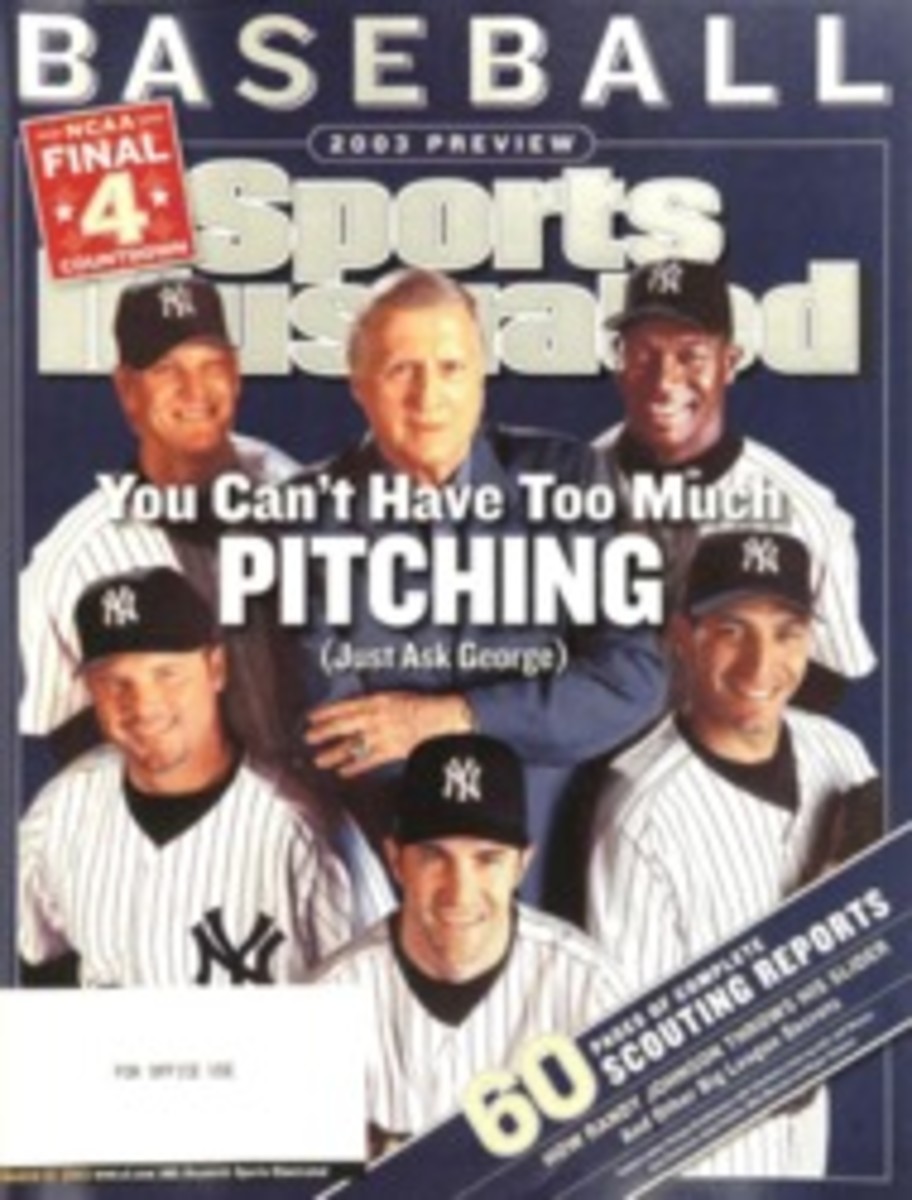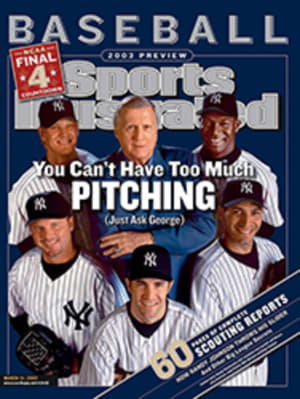
The Magic Number It's 120, the maximum pitch count for almost any starter under any circumstances. But does it really protect pitchers--or just managers?
The joy of the first complete game Mark Prior threw in the big
leagues diminished as soon as reporters stormed the Chicago Cubs'
clubhouse afterward to grill manager Bruce Kimm and pitching
coach Larry Rothschild. "I thought we were going to get burned at
the stake," Rothschild says.
What caused such an interrogation after Prior, then 21, struck
out 13 batters while beating the Colorado Rockies 4-1 last
August? The latest standard unit of measurement in the
increasingly Newtonian world of baseball: the pitch count. Prior
threw 136 pitches, which far exceeded protocol for a young
pitcher and sent townspeople running for their pitchforks and
flaming torches. As recently as last month an aghast American
League general manager, recalling the game, said, "A hundred and
thirty? I'd never do that."
Rothschild says he and Kimm allowed Prior, who ended the eighth
inning with 120 pitches, to complete the game because his
delivery was intact and he was not laboring. "It looked like he
was playing catch," Rothschild says.
How unscientific. Amadeo Avogadro, a turn-of-the-19th-century
physicist, found that equal volumes of gases, at the same
pressure and temperature, have the same number of chemical units
in one mole, a base unit of measurement in the metric system.
That number, known as Avogadro's number, is 6.02 x 10[23rd
power] and is represented by the symbol N. Baseball's
equivalent of Avogadro's number, according to popular wisdom,
is 120--i.e., all major league pitchers have the same number of
pitches in their arm before risking injury. It is represented
in your morning box score by the symbol NP, for number of
pitches. An NP greater than 20 is bound to set off alarms.
The pitch count is the addendum to the five-man rotation in
baseball's quest to keep pitchers healthy. To survive the stress
of getting through today's power-packed lineups, starting
pitchers throw less often and check out of games quicker than any
of their forefathers--and still break down with regularity. The
ability of starters to pitch out of trouble rather than rely on
relievers, to pitch with some fatigue, and to have the willpower
to be their own closers is dying out. The pitch count is here to
stay, but its one-size-fits-all dogma and low standard of
workload may actually hinder development of the game's most
precious resource.
"I'm torn," says Theo Epstein, the 29-year-old Boston Red Sox
general manager and a major proponent of statistical analysis. "I
believe in protecting young pitchers as much as anybody, but
maybe the pendulum has swung too far--so far that we're babying
young pitchers, and they don't get stretched out or learn how to
pitch out of jams."
Arizona Diamondbacks righthander Curt Schilling once said that
pitchers are like dogs: They'll do what you train them to do. And
most teams are training them not to throw more than 120 pitches.
The Red Sox, for instance, are one of many organizations that
have incremental pitch limits at every level of their minor
league system, maxing out at the magic 120 in Triple A. If the
number of pitches is tightly managed, the theory holds, so is the
risk of injury.
In nearly every major league dugout a coach or the next game's
starter uses a handheld clicker to count pitches during games.
More and more ballparks keep pitch counts on scoreboards. Think
of a kitchen timer: click, click, click ... Ding! He's done!
Reliance on the pitch count has become so prevalent and formulaic
that managers routinely explain away the removal of their
starting pitchers by saying, "Well, his pitch count was getting
up there." The number of 120-pitch games in the AL dropped 71% in
the past five years alone, from 289 in 1998 to 83 last year. The
number of 140-pitch AL games shrank from 17 to zero over the same
period.
"This whole issue is about managers not having the balls to give
whoever is out there the benefit of the doubt," says former
pitcher Jack Morris (page 70), who retired in 1994 after 18
seasons and 175 complete games, not including ones he threw in
spring training. "The negative effect is that pitchers have been
conditioned not to do it anymore, so they don't know how to do it
anymore. Kids today are bigger, faster, stronger. There's no
doubt they could pitch 250 innings, 300 innings if they had to.
Twenty complete games wouldn't be out of the question. But
they're never, ever conditioned to do that."
The pitch count is an old school versus new school battleground
on which crusty traditionalists such as Morris have lost out to
New Age risk-management thinkers such as Oakland A's pitching
coach Rick Peterson, whose motto is, In God we trust; all others
must show data. Peterson keeps a little black book in which he
logs with a four-color pen every pitch thrown by his starters,
even in bullpen sessions. He gauges pitches in 11-day increments.
So if a pitcher has a high-pitch-count game, his side session and
next start will be curtailed.
The mere counting of pitches is not new; teams have done it for
generations. It's the idolatry of fixed numbers as a training and
strategic device that has changed. Forty years ago Warren Spahn,
then 42, and Juan Marichal, then 25, threw 201 and 227 pitches,
respectively, in their famous 16-inning duel. Nolan Ryan was to
pitch counts what Tolstoy was to word counts. In an 11-week span
in 1974 Ryan threw 150 pitches (a two-hitter with eight walks and
11 strikeouts), 172 pitches (19 strikeouts), 184 pitches (an
11-inning, 1-0 loss to Mickey Lolich in which both pitchers
threw complete games) and--hang on to your clickers--235 pitches
(a 13-inning effort against Luis Tiant, who took a complete game
loss in the 15th inning). Ryan pitched for 27 seasons and started
more games than any other pitcher except Cy Young.
The statistical service STATS Inc. began tracking pitch counts in
1987, about the same time that many teams were announcing pitch
counts in the press box as part of a pitcher's line score. The
hegemony of the number, however, wasn't yet established. In the
1970s and '80s managers such as Earl Weaver and Billy Martin paid
more attention to radar-gun readings than pitch counts when
deciding when to remove a pitcher. Former Minnesota Twins manager
Tom Kelly consulted his watch. "I always thought most pitchers
began to tire after two hours, 10 minutes or two hours, 15
minutes," he says.
The shortening of the pitch-count leash began as signing bonuses
hit seven figures for high school pitchers--the Yankees gave
Brien Taylor an industry-rattling $1.55 million bonus in
1991--and the computer age sparked an explosion of statistical
information. Heightened awareness of numbers created heightened
concern. When USA Today started putting pitch counts in its box
scores in 1997, every fan with two quarters became an expert on
when to remove a pitcher. Last year the online magazine Salon.com
questioned why the Diamondbacks had allowed Randy Johnson to
throw 107 pitches in a game, hardly enough to raise a bead of
sweat on the brow of the game's premier workhorse.
Johnson, a more efficient version of Ryan, threw more pitches
last year (3,996) than any other pitcher in baseball, averaging
114 per start. He exceeded 120 pitches 10 times--more than the
entire staffs of 26 teams. Of the 4,852 starts by pitchers last
year Johnson accounted for the only one with 140 or more pitches:
a turn-back-the-clock 150-pitch workday against the Montreal
Expos. "Once he gets going, he seems to get stronger, and he
doesn't want to come out," says Seattle Mariners manager Bob
Melvin, the former Arizona bench coach. "He won't let you take
him out. Pitch counts go out the window."
Pitching coaches agree that how a pitcher runs up his pitch count
can be more important than the number itself, especially if he
labors through long innings. Says Anaheim pitching coach Bud
Black, "Take Ramon Ortiz. He's susceptible to getting out of his
delivery if he has a long inning. So he's more at risk [for
injury] if he throws more than 30 pitches in an inning than if he
throws 125 pitches easily."
No starting pitcher was as efficient last season as Atlanta
Braves righthander Greg Maddux, who needed, on average, only 13.3
pitches to get through an inning. Conversely, Philadelphia
Phillies pitch-guzzler Brandon Duckworth needed 17.7 pitches per
inning. Duckworth threw 234 more pitches than Maddux but had
36 1/3 fewer innings to show for it.
As for Prior, who had a 3.14 ERA in his five starts after the
136-pitch cause celebre, he has a new manager: Dusty Baker, whose
San Francisco Giants' staff led the majors last season in
120-pitch games, with 19. Says Prior, "My goal is to give the
team seven, eight solid innings every time out, and I want to go
nine." Will the almighty pitch count allow it?
"It's become so prevalent," Rothschild says, "pitchers are
monitoring it themselves. If you think you should be getting
tired because your pitch count is getting up there, you will be
tired. I'm not so sure we're not developing pitchers who are
conditioned to be tired at 120 pitches. Pitch counts have taken
on a life of their own."
COLOR ILLUSTRATION: ILLUSTRATION BY JOE CIARDIELLO
Of the 4,852 big league starts last season, Randy Johnson had
the only one with 140 or more pitches.

